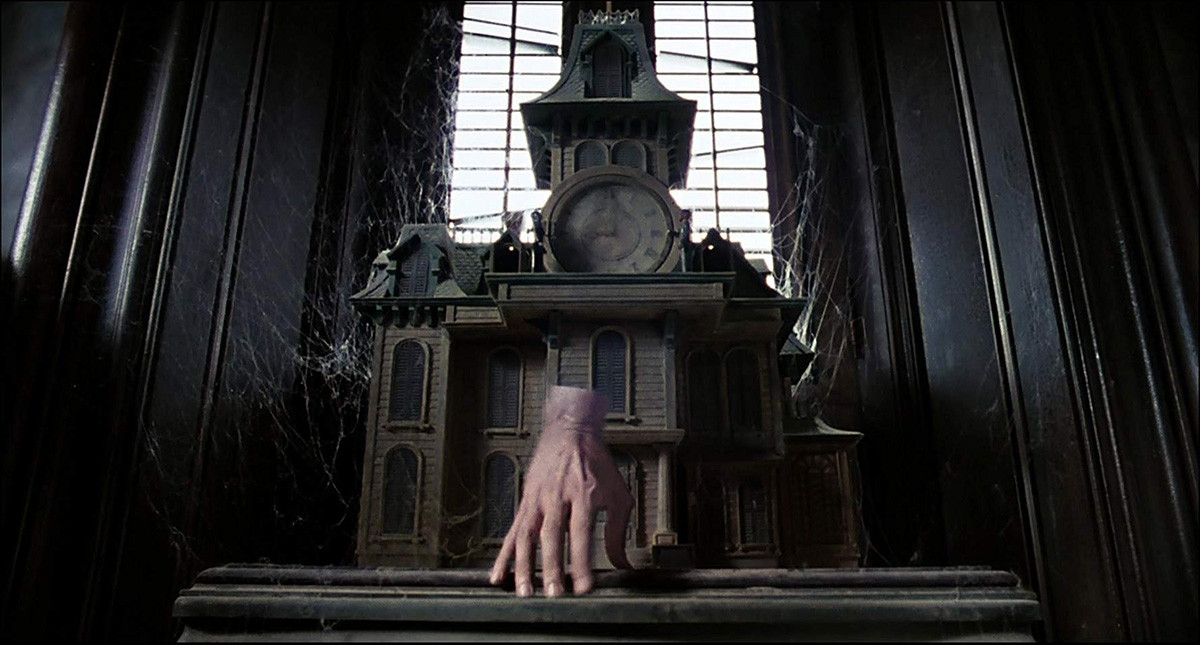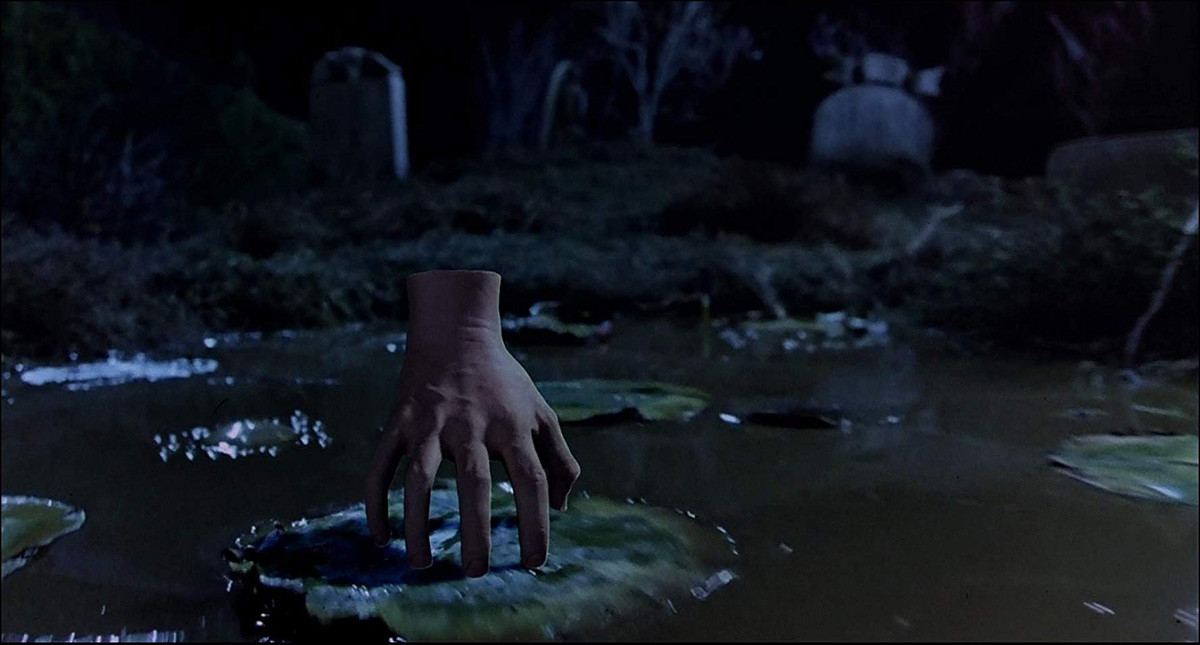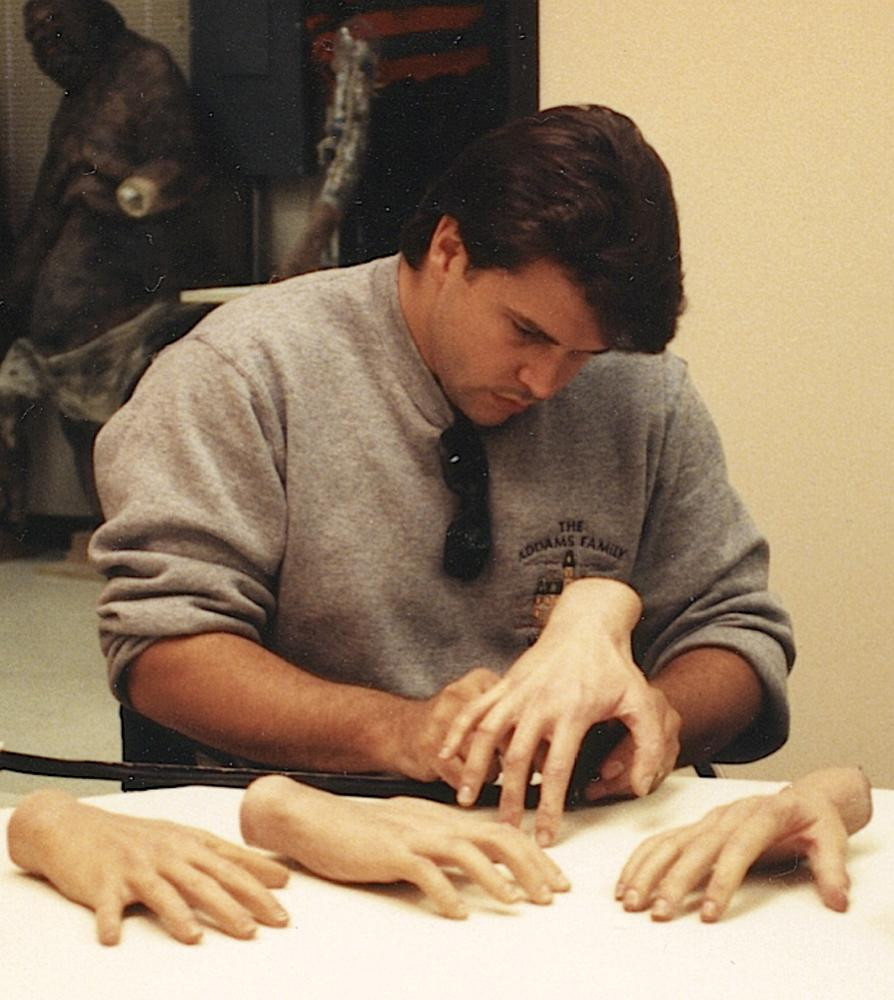Later this week, audiences will be introduced to a fresh animated rendition of The Addams Family, brought to life by directors Conrad Vernon and Greg Tiernan, and Cinesite. As anticipation builds for this new cinematic chapter, we take a nostalgic look back to the early 1990s, a period marked by Barry Sonnenfeld’s masterful direction of two Addams Family films. The first, released in 1991, The Addams Family, presented a unique challenge in visual effects: Thing, the family’s disembodied hand. More than just a prop, Thing was a pivotal character, demanding the ability to crawl, perform stunts, and genuinely ‘act’ within scenes.
In today’s filmmaking landscape, a ‘live-action’ Thing might effortlessly be rendered entirely through CGI. However, in the nascent stages of computer-generated imagery of the early 90s, the approach had to be different. So, the question arose: how could Thing be convincingly brought to life on screen? To uncover the secrets behind this iconic character, we turned to Alan Munro, the visual effects supervisor for The Addams Family (1991). Munro secured his role by suggesting a renowned dancer as movement reference for Thing, and later championed the use of a real human performer to embody the hand.
Munro’s recounting of the process, detailed below, offers a humorous and insightful look into the creation of Thing. It includes fascinating details about the hand casting process for the actor, the subtle use of prosthetics, and the meticulous rotoscoping techniques employed.
Alan Munro: My journey with The Addams Family began in the summer of 1990, in Scott Rudin’s office. It was a bright Monday morning… or perhaps it wasn’t. My memory of the precise day is hazy, a gentle reminder that recollections from three decades past are often viewed through a slightly distorted, liquor-stained lens. But I digress. I was there, basking in the sunlight on Scott Rudin’s brown leather couch, alongside Scott and director Barry Sonnenfeld, to interview for the position of visual effects supervisor. The inevitable question arose from Scott and Barry: “How will you create Thing?”
“Truthfully?” I responded, “I haven’t the faintest idea. And at this moment, I’m not concerned. First, we must define Thing’s essence, his role, his actions. Once we grasp that, the method of bringing him to life will reveal itself.”
 The iconic 'Thing' from The Addams Family (1991), showcasing the disembodied hand with a white cuff, crawling on a wooden floor.
The iconic 'Thing' from The Addams Family (1991), showcasing the disembodied hand with a white cuff, crawling on a wooden floor.
“Alright,” they inquired, taking the bait, “Who is Thing?”
“In the script, Thing is portrayed as a family pet, perhaps akin to a hamster, scurrying around the house. But in my vision, Thing transcends this. He needs to be imbued with magic. He needs to be reminiscent of Fred Astaire.”
“Fred Astaire?” they echoed, intrigued.
I elaborated: “Consider Fred. His characters aren’t overtly magical, they exist within our natural world. Yet, they seem unbound by its constraints. Fred’s grace, his elegance, his seeming effortlessness, his ability to dance up walls and across ceilings – it all appears utterly natural. This is the quality Thing must embody. Simultaneously natural and unnatural. Bound and unbound.”
And just like that, I secured the job.
 Close-up shot of Thing, the disembodied hand from The Addams Family, displaying the signature white cuff and Addams family crest cufflink, resting on a dark surface.
Close-up shot of Thing, the disembodied hand from The Addams Family, displaying the signature white cuff and Addams family crest cufflink, resting on a dark surface.
While I may have shaped Thing’s character, the visual design of Thing is owed to production designer Richard MacDonald, with a surprising contribution from a children’s birthday party puppeteer.
For me, Thing’s aesthetic was clear. Echoing the Fred Astaire concept, Thing should sport a crisp white French cuff, fastened with an Addams family crest cufflink. What would the wrist reveal? Intentionally, nothing. The deep cuff would cast a shadow, concealing its inner workings, maintaining an air of simple, elegant magic.
“Thing in a cuff is absurd,” designer MacD (Barry’s moniker for MacDonald) retorted, “It’s like adding a hat to a hat.”
“No,” I corrected, “It’s akin to a cuff on a wrist. But regardless, what’s your vision for Thing’s appearance?”
“The wrist’s interior should resemble a teacup.”
“Come again?” I replied, genuinely puzzled (and this particular line of dialogue, I recall verbatim).
“When you peer into an empty teacup, you can’t perceive the bottom,” MacD explained.
 Animated GIF of Thing, the Addams Family hand, rapidly moving and crawling, showcasing its lively and agile movements across a surface.
Animated GIF of Thing, the Addams Family hand, rapidly moving and crawling, showcasing its lively and agile movements across a surface.
MacD’s point, though somewhat abstract, was that the smooth, porcelain-like slope of a teacup’s interior creates an illusion of infinite depth, particularly to the inebriated eye.
MacD continued, “Given that Thing will be a puppet, this visual will be most effective.”
“Effective or not, Thing will not be a puppet,” I interjected. “Thing will be a real human hand, with the body optically removed.”
“No,” MacD insisted, “He will be a puppet. I’ve already secured a puppeteer.”
“This I have to witness.”
 Thing from The Addams Family (1991) interacting with a chess piece on a chessboard, highlighting its dexterity and ability to manipulate objects.
Thing from The Addams Family (1991) interacting with a chess piece on a chessboard, highlighting its dexterity and ability to manipulate objects.
The following day, a courteous gentleman in green-checkered trousers arrived at my office, carrying a large orange checkered carpet bag. He placed a cassette player on my desk. From the bag, he produced two marionette control bars, each connected to an articulated wooden hand by numerous strings. For the next three minutes, the wooden hand gracefully waltzed to The Blue Danube on my office carpet. The hand indeed featured a hollowed-out teacup wrist, designed to conceal the string attachments. Upon the waltz’s conclusion, the gentleman, with a thick Czech accent, inquired if I wished to see a goat dance the polka. I politely declined. Before departing, he kindly crafted a balloon dachshund for me.
Fortunately, I had invited everyone, including director Barry and producer Scott, to witness this demonstration.
The verdict was in: Thing would have a teacup wrist, but MacD would have no further influence on the effects process.
Sometimes, losing a minor skirmish leads to winning the overall war.
 Another animated GIF of Thing from The Addams Family, showing it running quickly across a surface, emphasizing its speed and comical nature.
Another animated GIF of Thing from The Addams Family, showing it running quickly across a surface, emphasizing its speed and comical nature.
Next, casting the hand. My initial choice for Thing was my friend, Don McLeod, a brilliant mime and Marcel Marceau’s apprentice. He was renowned as the “American Tourister Gorilla” (in commercials where Don, as a gorilla, attempted to break open suitcases). Initial camera tests with Don were conducted, and while his performance was exceptional, his somewhat stubby hand didn’t quite fit the envisioned aesthetic. Fred Astaire’s movements without Fred Astaire’s elegant form simply aren’t Fred Astaire. Don was out.
I compiled a list of alternatives. Beyond mimes, magicians were the obvious choice – individuals trained in intricate hand movements. A casting call went out to two dozen sleight-of-hand artists. The day they all responded was quite something. I’ve never been asked for so many quarters, had so many playing cards divined, or had so many eggs extracted from my ear. Ultimately, one candidate stood out.
Christopher Hart, a former assistant to David Copperfield (resembling Copperfield, he was used in several of David’s illusions), was a skilled magician in his own right. Chris was tall, intelligent, athletic, and possessed large, expressive hands. Moreover, Chris seemed remarkably normal, a surprisingly significant attribute after spending an afternoon with two dozen magicians.
 A still image of Christopher Hart as Thing from The Addams Family, showcasing his hand with the white cuff and cufflink, in a posed shot emphasizing the hand's expressiveness.
A still image of Christopher Hart as Thing from The Addams Family, showcasing his hand with the white cuff and cufflink, in a posed shot emphasizing the hand's expressiveness.
With Thing cast, the challenge shifted to achieving the visual effect. Seemingly straightforward now, but pre-computer era, everything relied on practical techniques or optical printers.
I consulted my friend and long-time collaborator, Pete Kuran. We decided on a two-pass shooting approach – one with Chris, one without. For front, top, and profile shots, Chris lay face-down on a car mechanic’s dolly, arm extended, wearing a black sleeve. A prosthetic wrist, turned upwards, created the illusion of a body positioned above. For shots from behind or when Thing turned around, Chris was positioned above the camera, a prosthetic around his wrist to define the edge.
Post-production involved rotoscoping – meticulously removing Chris’s body frame by frame. Pete, the originator of the Star Wars lightsaber effect, was Hollywood’s rotoscoping master. The background pass, sans Chris, filled in the removed areas. These elements were then combined using an optical printer. A simple concept, incredibly intricate in execution.
These optical shots of a real hand were interspersed with shots of hand puppets – not marionettes, but lifelike latex mechanical hands designed for specific actions (Thing as a golf tee, for example). For this, I enlisted Dave Miller, a collaborator from Nightmare on Elm Street.
This blend of techniques kept the audience guessing the effect’s method from shot to shot.
 David B. Miller working on the mechanical hand puppets for Thing from The Addams Family, showcasing the practical effects craftsmanship.David B. Miller at work on the mechanical hand puppets. Some were later part of an auction a few years ago.
David B. Miller working on the mechanical hand puppets for Thing from The Addams Family, showcasing the practical effects craftsmanship.David B. Miller at work on the mechanical hand puppets. Some were later part of an auction a few years ago.
On the first day of production, we positioned Chris under a table for Thing’s chess scene with Gomez. Camera stability was crucial for the two-pass technique. Unfortunately, the chess table wobbled incessantly. Stabilizing it became a major ordeal, the set transforming into a web of guy-wires. Barry nearly reached his breaking point. Following this, I was granted my own camera unit, effectively directing every shot featuring Thing in the film. This isn’t to claim Thing as solely my creation, more so than Barry Sonnenfeld’s, Chris Hart’s, Chuck Comisky’s, or the countless crew members. It was simply a matter of logistical organization.
Explore Alan Munro’s VFX credits at IMDB.
Stay informed on VFX news – Subscribe to befores & afters weeklies!
